Inside Track
ObamaCare Reduces Competition and Rations Care
The Affordable Care Act (ACA) was ostensibly enacted to protect average Americans from big insurance companies and to ensure that, as President Barack Obama put it, insurers “are limited in the ability to extract profits and deny coverage.” But ObamaCare has instead stimulated consolidation in the healthcare sector and rationing of care, according to a February 11 report from the American Action Forum (AAF), a center-right think tank in Washington, D.C.
Until recently, most physicians maintained independent solo or small-group practices; few were employed by hospitals. Lately, however, hospitals “have been forming physician groups, which have in turn been buying up physician practices at a rapid rate,” wrote AAF’s Robert Book, a health economist. In addition, noted Book, “Hospital groups across the country have also started forming their own health insurance companies … with their own facilities and physicians as the main in-network providers.”
The ACA encourages health plans to have narrow provider networks. Also, through the Medicare Shared Savings Program, the law establishes a system of Accountable Care Organizations (ACOs) for Medicare patients, the objective of which is to control costs. ACOs are groups of healthcare providers who agree to care for at least 5,000 patients.
If an ACO includes many of the major hospitals, then it becomes a lot easier to guide patients to the level and type of utilization desired — which is, for purposes of the Medicare Shared Savings Program, always less utilization. And of course, it is much easier to enforce referral and utilization policies on physicians who are employees of a group running the ACO, rather than simply independent businesses who happen to join an ACO at a given moment in time.
The Medicare Shared Savings Program encourages hospitals and physicians of different specialties to join together in order to encourage patients to use less healthcare. Put more bluntly, the purpose of ACOs is to ration care, and the best way they can achieve that objective is to grow larger and larger until patients have little choice but to submit to their dictates.
Feds Seek “Mental Health” Testing of All Children, Adults
A panel advising the Obama administration, in partnership with Big Psychiatry, wants to make doctors subject all American adults and children over age 12 to screening for alleged “mental health” disorders. Anyone found to harbor any alleged mental disorder, including children as young as eight, should undergo “therapy,” often including powerful psychotropic medications that experts say have dubious value but often come with well-documented and dangerous side effects.
The latest recommendations for children and adolescents 12 and older were published February 9 in the Annals of Internal Medicine. “The USPSTF [United States Preventive Service Task Force] recommends screening for major depressive disorder (MDD) in adolescents aged 12 to 18 years,” the HHS task force said in the summary of its position. “Screening should be implemented with adequate systems in place to ensure accurate diagnosis, effective treatment, and appropriate follow-up.” Why the federal government believes it has any business coming between patients and doctors — or where it believes the constitutional authority for such meddling is found — was not immediately clear.
When it comes to adults, the advisory panel wants to cast an even broader net. “The USPSTF recommends screening for depression in the general adult population, including pregnant and postpartum women,” said the outfit, which adds that its views should not be construed as the official position of the “Agency for Healthcare Research and Quality” or Obama’s HHS. “Screening should be implemented with adequate systems in place to ensure accurate diagnosis, effective treatment, and appropriate follow-up.”
The outfit downplays the very serious risks associated with antidepressants. For instance, the panel admits that antidepressants are “associated” with harms, including an increase in suicidal behavior, an increased risk of gastrointestinal bleeding, fetal harm, and more. But despite that, the task force “concludes with at least moderate certainty that there is a moderate net benefit” to screening all American adults. And by all, the task force means all: “The USPSTF recommends screening in all adults regardless of risk factors,” it said.
Record Number of Abortion Facilities Have Closed Since 2011
Since 2011, at least 162 abortion facilities across the nation have either closed completely or stopped performing abortions, while only 21 new abortion facilities have opened. These statistics were compiled by Bloomberg News over the past three months and reported on February 24.
Texas led the nation in the number of abortion facilities closed, with 30, followed by Iowa with 14, Michigan with 13, and California with 12. While the decline in facilities providing abortions is generally attributed to more stringent restrictions imposed by new state laws, the decline in California, which besides being the nation’s most populous state is also dominated by Democratic legislators who tend to be favorable to “abortion rights,” goes against this trend, suggesting multiple reasons for the decline.
A report on the closings at LifeNews.com noted other factors responsible, including a decline in the number of doctors willing to perform abortions, a decline in the number of women seeking abortions, and increasing reliance on the “morning after” pill, all of which result in a loss of business and therefore make abortion less profitable.
Another major factor that has reduced the demand (and therefore, the financial rewards) for abortion has been greater education about the nature of abortion, which has caused many women who had previously considered abortion to have a change of heart.
While the reduction in the number of abortion facilities in our nation is good news for those who are committed to the right to life for all unborn children, with 739 abortion clinics remaining in the United States, their work still has a long way to go. Short of a reversal of the Supreme Court’s infamous Roe v. Wade decision, which would allow states such as Texas to restrict abortion unimpeded by interference from federal judges, the end of the abortion holocaust is still a long way off.
JBS Member?
Sign in with your ShopJBS.org account.
 Subscribe Now
Subscribe Now
- 24 Issues Per Year
- Digital Edition Access
- Digital Insider Report
- Exclusive Subscriber Content
- Audio provided for all articles
- Unlimited access to past issues
- Cancel anytime.
- Renews automatically
 Subscribe Now
Subscribe Now
- 24 Issues Per Year
- Print edition delivery (USA)
*Available Outside USA - Digital Edition Access
- Digital Insider Report
- Exclusive Subscriber Content
- Audio provided for all articles
- Unlimited access to past issues
- Cancel anytime.
- Renews automatically


